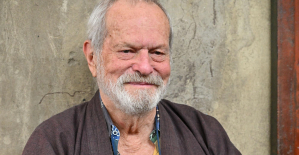"Southwest Florida is my paradise on Earth, and in South Florida there are hurricanes. You have to deal with it," the 28-year-old said in front of a debris-strewn street.
"I'm ready to go with it, it's my favorite place, it's worth it," he told AFP.
Despite warnings from experts, who warn of the increased likelihood of violent hurricanes and floods due to climate change, the southeastern coasts of the United States are still attracting more inhabitants.
A particularly striking paradox in Cape Coral, where Kenneth Lowe lives.
Between 2010 and 2021, its population grew by a third to reach 200,000 people. Founded in 1958, this city embodies the dream that many come to Florida for.
The area is criss-crossed by navigable canals giving access to the Caloosahatchee River, which empties into the Gulf of Mexico. Thus, many people can enjoy a house with a view of the water, and even a small boat.
But the region, initially marshy, had to be drained. Mangroves and corals have been destroyed. Result: a city very vulnerable to flooding.
She was hit hard by Ian, who got stronger very quickly, fueled by warmer waters and higher humidity in the air due to climate change.
In the streets of Cape Coral, dozens of residents are now piling up their belongings in front of their homes: beds, cupboards or refrigerators that have become unusable.
"We are going to rebuild and we hope it will be 100 years before the next big storm," Tamara Lang, 56, told AFP.
She moved from Chicago (north) and bought her house in Cape Coral only a few months ago. In making her choice, she did not think of hurricanes. But she has no intention of leaving. "We love being here. It's been our cocoon of happiness since we arrived."
- Rapid growth -
For the sociologist and demographer Mathew Hauer, who studies the effect of climate change on migration, the population is not as informed as it should be about the dangers.
"If people really understood the flood risk for these properties, we would see changes in where they choose to buy their homes and live," said the assistant professor at Florida State University.
Another problem: the maps of flood zones drawn up by the federal agency in charge of natural disasters (Fema) are "obsolete", explains to AFP Gavin Smith, professor of environmental planning at the University of North Carolina. "They should be seen as a minimum but are often used to regulate where and how to develop" a city, he says.
According to US Census data, counties bordering the coasts of North, South and Georgia Carolina are clearly gaining the most residents. Florida had 2.7 million more residents in 2020 (21.5 million total) than in 2010.
"The southeastern United States continues to grow very rapidly," says Mathew Hauer, "and I don't see any signs that the southward migration trend is going to reverse."
However, if the sea level rises by 0.9 meters by the end of the century, around 4.5 million people will have to move to the United States, according to a study published in the journal Nature. Florida accounts for a quarter.
- Paradox of immobility -
The "State of the Sun", as it is nicknamed, particularly attracts many retirees. The coasts also represent an economic pole, with jobs that can be directly linked to the sea (fishing, tourism, etc.).
And, once installed, difficult to leave.
A majority of Americans (67%) say they would rather rebuild their home than move after a natural disaster, according to a 2021 poll.
This is called "the paradox of immobility", explains Mathew Hauer. The reasons are partly psychological: fleeing gives the impression of "giving up".
But they are also social - not to move away from loved ones - and economic.
In addition, "minimizing the real risks we face" is "a universal human trait", believes Gavin Smith.
Irene Giordano, 56, moved to Cape Coral from (eastern) Virginia in 2019. "I don't think we're going to leave because we have nowhere to go," she said. In his house, the water rose up to 50 cm. "I pray this will be the last time in my life."

 United States: divided on the question of presidential immunity, the Supreme Court offers respite to Trump
United States: divided on the question of presidential immunity, the Supreme Court offers respite to Trump Maurizio Molinari: “the Scurati affair, a European injury”
Maurizio Molinari: “the Scurati affair, a European injury” Hamas-Israel war: US begins construction of pier in Gaza
Hamas-Israel war: US begins construction of pier in Gaza Israel prepares to attack Rafah
Israel prepares to attack Rafah First three cases of “native” cholera confirmed in Mayotte
First three cases of “native” cholera confirmed in Mayotte Meningitis: compulsory vaccination for babies will be extended in 2025
Meningitis: compulsory vaccination for babies will be extended in 2025 Spain is the country in the European Union with the most overqualified workers for their jobs
Spain is the country in the European Union with the most overqualified workers for their jobs Parvovirus alert, the “fifth disease” of children which has already caused the death of five babies in 2024
Parvovirus alert, the “fifth disease” of children which has already caused the death of five babies in 2024 Falling wings of the Moulin Rouge: who will pay for the repairs?
Falling wings of the Moulin Rouge: who will pay for the repairs? “You don’t sell a company like that”: Roland Lescure “annoyed” by the prospect of a sale of Biogaran
“You don’t sell a company like that”: Roland Lescure “annoyed” by the prospect of a sale of Biogaran Insults, threats of suicide, violence... Attacks by France Travail agents will continue to soar in 2023
Insults, threats of suicide, violence... Attacks by France Travail agents will continue to soar in 2023 TotalEnergies boss plans primary listing in New York
TotalEnergies boss plans primary listing in New York La Pléiade arrives... in Pléiade
La Pléiade arrives... in Pléiade In Japan, an animation studio bets on its creators suffering from autism spectrum disorders
In Japan, an animation studio bets on its creators suffering from autism spectrum disorders Terry Gilliam, hero of the Annecy Festival, with Vice-Versa 2 and Garfield
Terry Gilliam, hero of the Annecy Festival, with Vice-Versa 2 and Garfield François Hollande, Stéphane Bern and Amélie Nothomb, heroes of one evening on the beach of the Cannes Film Festival
François Hollande, Stéphane Bern and Amélie Nothomb, heroes of one evening on the beach of the Cannes Film Festival Skoda Kodiaq 2024: a 'beast' plug-in hybrid SUV
Skoda Kodiaq 2024: a 'beast' plug-in hybrid SUV Tesla launches a new Model Y with 600 km of autonomy at a "more accessible price"
Tesla launches a new Model Y with 600 km of autonomy at a "more accessible price" The 10 best-selling cars in March 2024 in Spain: sales fall due to Easter
The 10 best-selling cars in March 2024 in Spain: sales fall due to Easter A private jet company buys more than 100 flying cars
A private jet company buys more than 100 flying cars This is how housing prices have changed in Spain in the last decade
This is how housing prices have changed in Spain in the last decade The home mortgage firm drops 10% in January and interest soars to 3.46%
The home mortgage firm drops 10% in January and interest soars to 3.46% The jewel of the Rocío de Nagüeles urbanization: a dream villa in Marbella
The jewel of the Rocío de Nagüeles urbanization: a dream villa in Marbella Rental prices grow by 7.3% in February: where does it go up and where does it go down?
Rental prices grow by 7.3% in February: where does it go up and where does it go down? Even on a mission for NATO, the Charles-de-Gaulle remains under French control, Lecornu responds to Mélenchon
Even on a mission for NATO, the Charles-de-Gaulle remains under French control, Lecornu responds to Mélenchon “Deadly Europe”, “economic decline”, immigration… What to remember from Emmanuel Macron’s speech at the Sorbonne
“Deadly Europe”, “economic decline”, immigration… What to remember from Emmanuel Macron’s speech at the Sorbonne Sale of Biogaran: The Republicans write to Emmanuel Macron
Sale of Biogaran: The Republicans write to Emmanuel Macron Europeans: “All those who claim that we don’t need Europe are liars”, criticizes Bayrou
Europeans: “All those who claim that we don’t need Europe are liars”, criticizes Bayrou These French cities that will boycott the World Cup in Qatar
These French cities that will boycott the World Cup in Qatar Medicine, family of athletes, New Zealand…, discovering Manae Feleu, the captain of the Bleues
Medicine, family of athletes, New Zealand…, discovering Manae Feleu, the captain of the Bleues Football: OM wants to extend Leonardo Balerdi
Football: OM wants to extend Leonardo Balerdi Six Nations F: France-England shatters the attendance record for women’s rugby in France
Six Nations F: France-England shatters the attendance record for women’s rugby in France Judo: eliminated in the 2nd round of the European Championships, Alpha Djalo in full doubt
Judo: eliminated in the 2nd round of the European Championships, Alpha Djalo in full doubt


















